Flooring
Furniture and fittings, you may be able to change with the time however the flooring is something there for a very long period of time. As choosing your flooring needs lots of effort and also it will cost you a fortune. Also, choosing flooring for your new home is not an easy task. There are so many options available for flooring materials to choose from a wide range in market. There are various types of flooring materials are available in the market, so it is bound to happen where people get confused while choosing which flooring material is best for their home.
Choosing flooring materials usually depend upon the following criteria: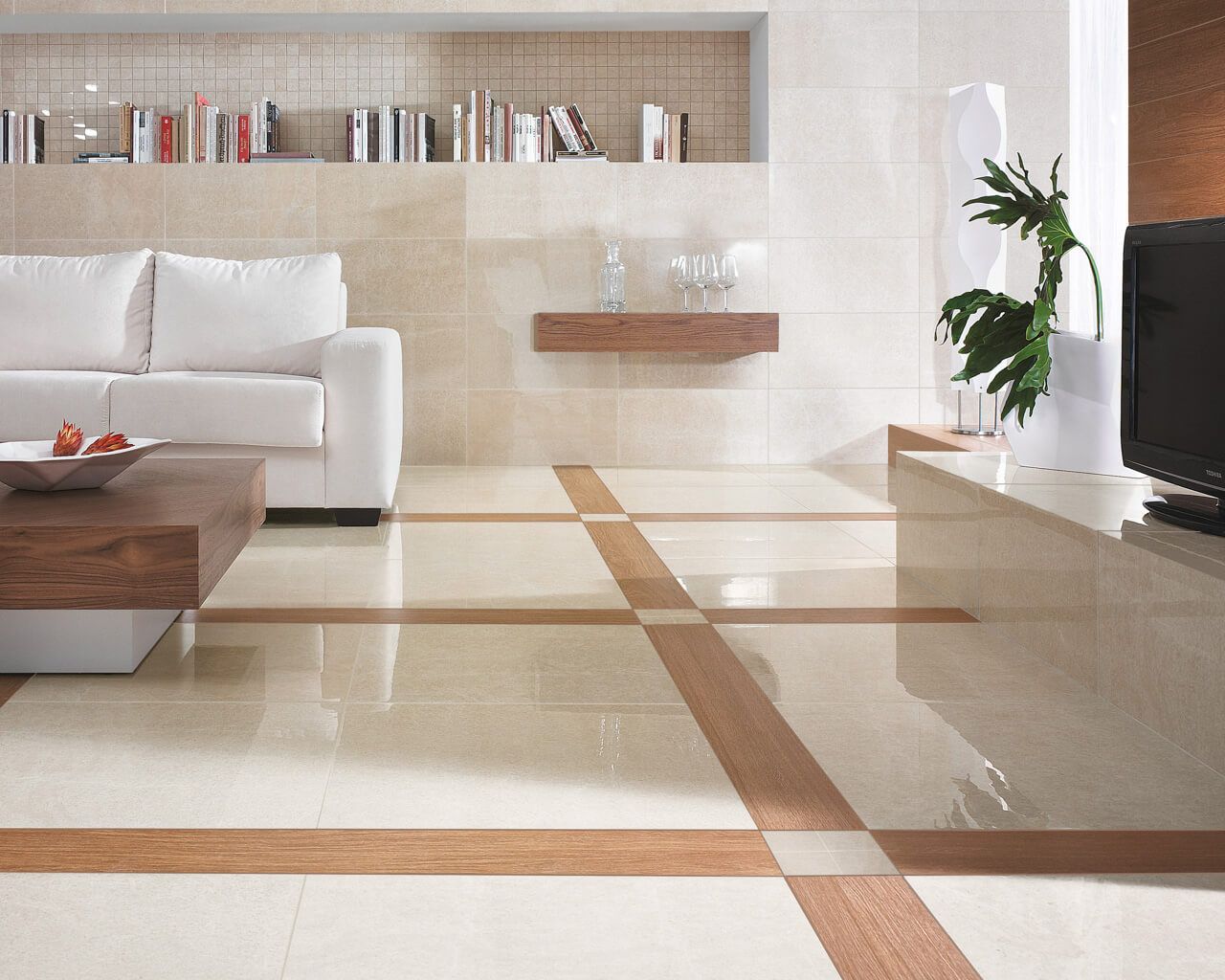
• Choices
• Uses
• Quality
• Traffic (High, Low or Medium)
• Difficulty of Installation
• Required Level of Finishing
• Maintenance (cleaning)
• Economy
Here we have tried to define various types of flooring materials which are most popular nowadays:
Types of Flooring Materials
01. Tiles Flooring
a. Ceramic Tiles Flooring
b. Porcelain Tiles Flooring
02. Stone Flooring
a. Marble Flooring
b. Granite Flooring
03. Wood Flooring
a. Solid Wood Flooring
b. Engineered Wood Flooring
c. Laminate Wood Flooring
4. PVC or Vinyl Flooring
5. Brick Flooring
01. Tiles Flooring
Among all the type of flooring used in the house, “tile flooring” is a very common and popular. The tiles are available in varieties of colors, textures and patterns. Tiles flooring also have types like ceramic tiles, porcelain tiles, etc. We have tried to give a brief explanation on two most commonly used types of tiles:
a. Ceramic Tiles Flooring
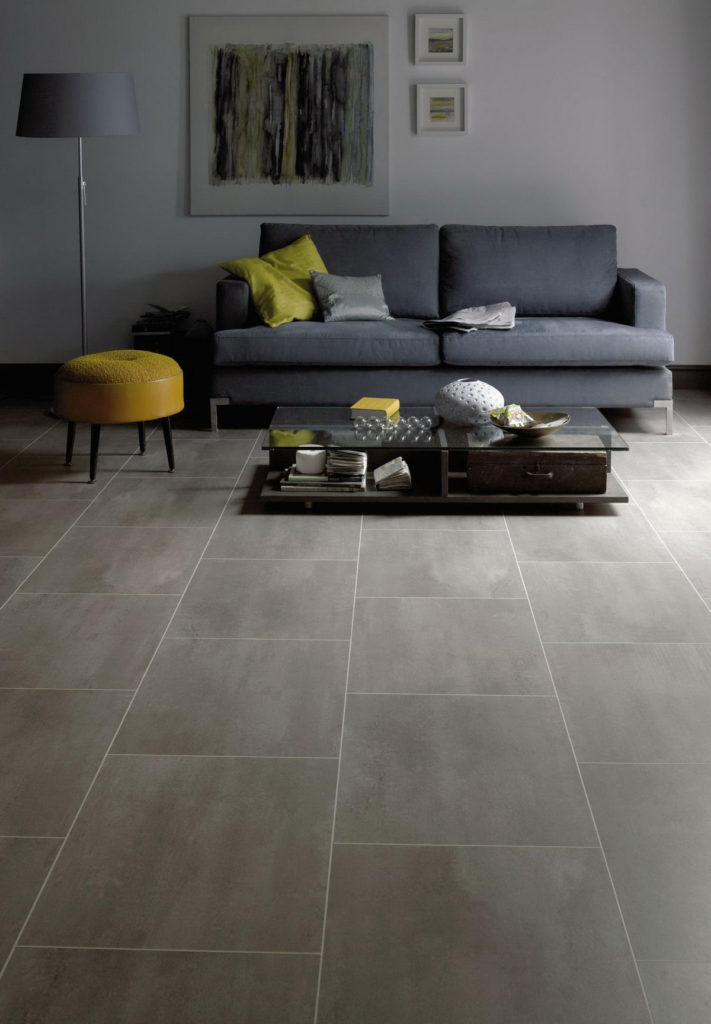 Ceramic tile is made up of mixture of clay and water only. It is used in indoor as well as outdoor areas. Ceramic tiles are ideal for wet areas like bathrooms, kitchens, etc. as these tiles are not very slippery as compared to vitrified tiles. Architectural versatility for flooring comes in the form of ceramic tiles. You can install ceramic flooring in a broad range of environments. So let’s find out the pros and cons of ceramic tile flooring.
Ceramic tile is made up of mixture of clay and water only. It is used in indoor as well as outdoor areas. Ceramic tiles are ideal for wet areas like bathrooms, kitchens, etc. as these tiles are not very slippery as compared to vitrified tiles. Architectural versatility for flooring comes in the form of ceramic tiles. You can install ceramic flooring in a broad range of environments. So let’s find out the pros and cons of ceramic tile flooring.
Pros and Cons of Ceramic Tile Flooring
Pros:
1. Water Resistance
The glazed version of ceramic tiles has an excellent protective layer on top of the material. It provide stain and water resistance. In fact, ceramic flooring also offers protection against high humidity penetration. Such characteristics make it suitable for moist settings like the kitchen and bathroom. On the other hand, the unglazed version requires sealing to provide liquid protection. You will find grout lines between the ceramic tiles, which are prone to moisture. So these also need sealing to keep water at bay. Otherwise, liquids seep down the grout lines and weaken the installation.
2. Durability
Ceramic tiles have an incredibly resilient nature. And this means that the flooring is a hard nut to crack. High-quality installation tends to last for as long as 20 years. And even longer if the flooring is well maintained. On top of that, if one ceramic tile somehow gets damaged due to severe impact, you can replace that one in no time.
3. Maintenance
When it comes to maintenance, there’s nothing you need to worry about with ceramic tile flooring. Liquids, stains, and dirt are not difficult to clean. You can vacuum or sweep the floor using a brush attachment as a part of regular maintenance.
For heavy-duty stains, cleaners are the best options. And such appliances don’t tend to damage the hard material of ceramic flooring.
4. Cost-Effective
Even though ceramic tiles are slightly expensive, they offer great value for money. When compared to other flooring options, ceramic tiles are moderately costlier.
On the other hand, wood flooring and carpet are more on the affordable side. But they don’t last as long as ceramic tile flooring. Once installed correctly, ceramic tiles add lifelong value to your home.
5. Allergen Concerns
Due to the solid, hard surface, ceramic flooring doesn’t attract allergens like pollen, dust, and dirt. Even when these elements are present on the tiles, you can spot them easily. So all you need to do at such times is wipe away the mess with a sponge or mop. This is good news for people suffering from asthma or allergies. Ceramic tiles are an excellent option if you want to keep the environment in your house free of harmful or irritating particles floating in the air.
Cons:
1. Hard Flooring
The solid, hard surface of ceramic tiles may be easy to maintain and clean, but that doesn’t make them comfortable to step or stand on. These tiles are not like resilient floors. That means you cannot soften them with padded underlayment. Such a nature of ceramic flooring makes it unsuitable for spaces where people have to stand for long hours of the day. So the best solution to this problem is covering up the floor with area rugs. You can place rugs in the spots where people tend to stand more often.
2. Temperature
When winter sets in flooring kept on cold. But it also means a cold floor during the summer season definitely good for Pakistan’s weather.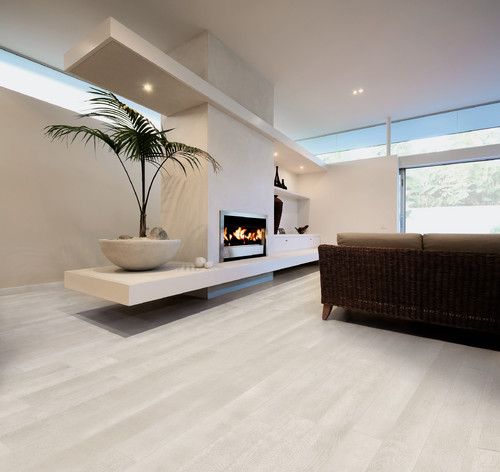
3. Installation
These kinds of tiles are heavy and hard in quality. Installing them means using a broad range of tools, grouts, and mortars. The process can be carried out by only by a professional. But the problem here is that it’s time-consuming. And even a single mistake can ruin the whole procedure, thus leading to major problems along the way.
Final Verdict
So what have we gathered from the pros and cons of ceramic tile flooring? That it’s an excellent choice for those who want easy maintenance and long-lasting value. Due to their exceptional water resistant quality, ceramic tiles are a great option for bathrooms and kitchens as well.
b. Porcelain Tiles Flooring
Porcelain tiles are the type of vitrified tiles. It is staining and water resistant. Porcelain tiles are most commonly used in living room, kitchen, bedroom, etc. They have a glossy finish as compared to ceramic tiles though they are also available in matt finish. Porcelain tiles is made by hydraulic pressing a mixture of clay, quartz, feldspar and silica, which make vitreous surface. Thus creating a single mass making them hard with low porosity. Different clay bodies reach vitrification at different temperatures.
There are various types of vitrified tiles available in the market like;
• Full Body Porcelain Tiles:
Full body Porcelain tiles have pigment in entire thickness of the tile. Therefore, scratches are less noticeable in these types of vitrified tiles. Also, when you have to cut the tiles, borders of tiles will be of the same color.
• Double Charge Porcelain Tiles:
Double charge Porcelain tiles are fed through a press that prints the pattern with a double layer of pigment (two kinds of colours are fed into the machine). Therefore, the upper layer becomes 1 to 2 mm thicker. So, it is a viable option where traffic is medium to heavy.
• Soluble Salt Porcelain Tiles:
Porcelain tiles are printed with screen printing technology and then polished, therefore it is called soluble salt.
• Glazed Porcelain Tiles:
Glazed Porcelain Tiles has a glazed surface. This glazed surface allows any type of design, surface textures, etc. on it. It can increase the aesthetics of the area.
The advantages and disadvantages of porcelain tile floors
There are many porcelain tile benefits to consider, and all those benefits come together to make a porcelain tile floor highly attractive. Taking the time to get familiar with all the different benefits will make the price tag easier to deal with, and before you know it, you might be happily paying for a porcelain tile installation of your own.
Resists wear:
Porcelain tile is highly resistant to wear and tends to last better over the years. That’s because porcelain tile has fewer air pockets, it’s a denser material, it’s more uniform in construction and tends to be harder and thicker overall than most other tile varieties. Porcelain tile floors are known to last for years, and they are a top choice for business use or in rental properties because of just how durable they are over time.
Low Maintenance:
Maintaining flooring can be really intensive when you have something like hardwood flooring, or it can be quick and easy when you have porcelain tiles. Porcelain tiles look great, they’re tough, and they are simple to maintain. They don’t require any special sealing to keep out water as some other tiles do. Porcelain tile floors are simple to clean and water wipes right off them without causing any real damage. That’s why porcelain tile is used heavily in kitchens, bathrooms and entryways. They aren’t entirely waterproof but are resistant enough to make them easy to keep clean and in good shape over time. Porcelain tile floors are some of the easiest to maintain out of all the different flooring varieties available.
They’re beautiful:
One of the huge porcelain tile benefits is the way that the material looks. It’s made from high-quality components and put together to be an almost luxury product. This tough tile solution looks better than most ceramic tiles and will transform your space into something you are truly proud of. The flooring comes in a range of appearances, and some of the styles of porcelain tile are truly stunning.
Excellent for high traffic use:
Porcelain tile floors are perfect for high traffic environments for a few different reasons, which makes them so desirable for business use. This flooring is highly resistant to wear, and breakage, even against the rough nails of pets. The floors are highly moisture resistant and simple to clean as well. Those different benefits come together and make porcelain tile floors perfect for high traffic environments. Business owners or homeowners that like to throw parties can really benefit from porcelain tile installation. Porcelain tiles will hold up to the use and abuse of everyday life, and you can just enjoy the way they look without spending hours on maintenance tasks.
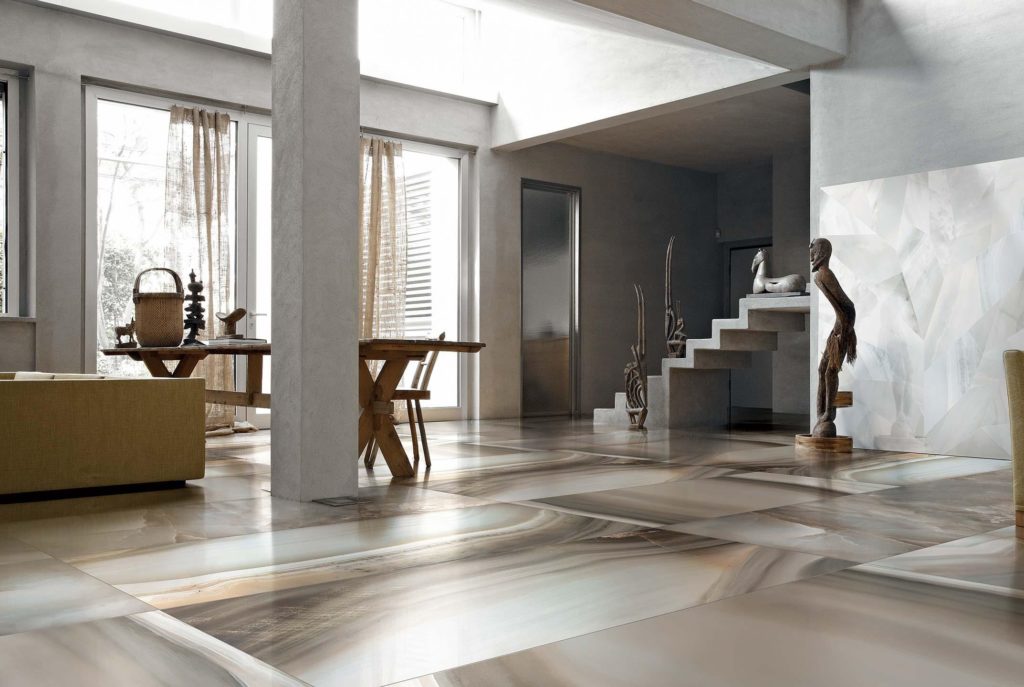 Offered in a wide range of styles:
Offered in a wide range of styles:
Anyone can be happy with porcelain tiles, which is another one of the porcelain tile benefits. This flooring option can be made to look like most other types of flooring to suit your tastes. Porcelain tiles can be made to look like marble, granite, slate, hardwoods, limestone and just about any other type of flooring that you are interested in. Porcelain tile is highly diverse, which means you don’t have to settle for one particular style when investing in porcelain. Instead, you can get any appearance that you would like, and settling isn’t necessary. With all the different options available for look, color, pattern, and size when it comes to picking out porcelain tile, it’s simple to match any style that you are interested in having in your home.
Highly durable:
One of the most important porcelain tile benefits is its durability. Porcelain tile is made from highly refined clay that’s fired at higher temperatures and designed to hold up better than most other types of flooring on the market. If you have pets, or you are just hard on floors in general, there are few options better than porcelain tile for long-lasting wear resistance. You should seriously consider porcelain tile because it just holds up well and isn’t hard to care for either. It’s tough to damage the flooring, and it is possible to replace it in the future piece by piece if necessary.
More moisture resistant:
One major issue that some homeowners in cold climates experience with ceramic tile is cracking due to moisture issues. That’s because damp tile exposed to freezing temperatures will crack apart. Porcelain tile is much less likely to suffer from this problem though. That’s because porcelain tile floors are denser and more uniform and much less porous than other tile varieties. There isn’t as much of a chance that moisture will seep through porcelain tiles, which leaves you with a stronger and more reliable form of flooring.
Simple to clean:
Porcelain tile doesn’t harbour bacteria like more porous material does, and it’s very simple to wipe off and keep clean over time. It can be treated like most other tiles and swept and mopped without issue. The tile stays cleaner than traditional tile and doesn’t suffer from staining as easily either. Business owners will love how easy it is to keep porcelain tile floors in good shape and looking good, but so will homeowners that want a neat and tidy looking space to live in.
The Disadvantages of Porcelain Tiles
There are plenty of reasons to like porcelain tile floors, but those porcelain tile benefits don’t excuse the downsides to this type of flooring. There are some issues with this type of flooring that you should be aware of as well before deciding on the solution for your home or business.
Difficult to install:
Since porcelain tile is denser, it’s more difficult to work with as well. The things that make it so long-lasting and reliable, also make it harder to cut through and layout properly. Porcelain tile is highly dense, and only the most experienced flooring professionals should attempt porcelain tile installation.
More expensive:
When you’re working with a pretty tight budget, the price can be another concern with porcelain tiles. They aren’t outrageously priced, but they tend to cost more per tile than marble flooring, and they are costlier to have installed as well. If you are attempting to get the most affordable flooring that you can, porcelain tile floors might not be your best option. On the other hand, the flooring is likely to last for years longer than more affordable solutions, so it could actually be a better value over the long term than a more affordable flooring option. Porcelain tile floors are certainly more, which you have to think about, especially if your budget is already being stretched, but it shouldn’t be your only concern when choosing a flooring type to go with.
More difficult to repair:
Finally, porcelain tile is more difficult to repair than ceramic tile flooring is. That’s because the tiles are more difficult to work with, and you’ll likely be quoted a higher price if you have to bring professionals in to swap out tiles for you. With that said, it’s less likely that porcelain tile floors will need repairs in the future. If you compare repair costs between porcelain tile floors and another option other than porcelain tiles, the costs would likely be comparable since repairs aren’t necessary as much as tough porcelain tile flooring solutions.
It’s important to really think about the porcelain tile benefits as well as the downsides to this flooring solution. As long as you don’t mind the added cost of the flooring, the added weight that it brings to your home or business, or the difficulty to repair or install, it’s really worth considering as a flooring solution. Porcelain tile is one of the toughest floor varieties that you can go with, and it’s an excellent option for pet owners. The flooring can look any way that you want it to, it does well in most areas of the home and is worth some serious consideration, just make sure that you work with professionals to help you come up with the right flooring for your needs.
Porcelain vs. Ceramic Tile
Porcelain vs. ceramic tile: Is this a war between two vastly different types of materials or simply a war of words? The terms porcelain and ceramic are often used interchangeably as if they were the same thing. Tile shop salespeople often claim a world of difference between the two in order to justify porcelain’s cachet and its higher prices. But there is not much difference between porcelain and ceramic tile.
Porcelain and Ceramic Tile Basics
As it turns out, ceramic and porcelain are composed differently and do behave accordingly upon installation, but with only slight differences. The chief difference is that porcelain tile is more impervious than ceramic tile and is thus subject to less water infiltration. Porcelain tile has a water absorption rate of 0.5 percent or lower. First, fired tile is weighed. Then it is boiled for five hours and let to sit in water for 24 hours. Next, it is weighed again. If the tile weighs less than half of one-percent more as a result of water absorbing into its surface, it is considered porcelain.
Porcelain tile is often extruded; has fewer impurities than ceramic; is often rectified; and often contains more kaolin than ceramic. It is formed of quartz, clay, and feldspar that is fired at temperatures ranging from 1,200 to 1,400 degrees C.
But since that also defines many ceramics, again the difference is that porcelain has that 0.5 percent or less water absorption rate.
02. Stone Flooring
Stone flooring is natural, beautiful, and always stylish that stands out in contrast to any synthetic or manufactured stone products. Natural stone also comes in different types such as granite, marble, limestone, slate, travertine, sandstone, etc. All the types of stone have different characteristics. The naturally cool, hard surface is ideal for warm climates.
a. Marble Flooring
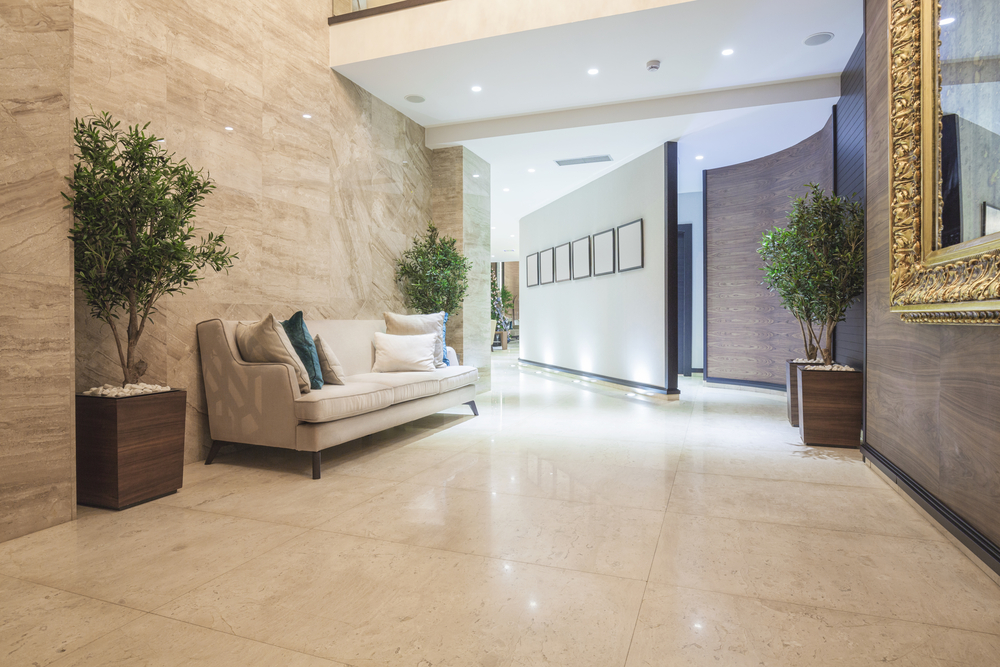 Marble is a metamorphic rock. Marble tile is a natural floor surface covering that is quarried from mountains around the world. Priced for its beauty, style, and elegance, this material has graced the palaces of kings and queens for centuries, making it an upscale, luxurious option for interiors. However, there are some serious drawbacks and maintenance concerns that come with the installation of these floors, that need to be understood before a purchasing choice is made.
Marble is a metamorphic rock. Marble tile is a natural floor surface covering that is quarried from mountains around the world. Priced for its beauty, style, and elegance, this material has graced the palaces of kings and queens for centuries, making it an upscale, luxurious option for interiors. However, there are some serious drawbacks and maintenance concerns that come with the installation of these floors, that need to be understood before a purchasing choice is made.
Marble Flooring Pros
Style:
The biggest advantage of marble floor tile is that it can instantly elevate the appearance of a space, giving it a regal bearing that is hard to imitate. At the same time marble is available in multiple colors, and even in stunning multicolor mixes, providing flexible options for a variety of decorative schemes. Tiles can also be cut to rectangles, and triangles of varying sizes, in order to create complex mosaic piece installations.
Unique:
Because it is a product of the earth, every single piece of marble tile used in every single floor is a one of a kind, and there is no other like it anywhere in the world. In the case of multi colors this can be quite extreme, with distinct features blaring forth from every tile.
Natural:
The look of a marble floor can bring the stunning power and dignity of a flowing mountain range into an interior space. Even if the material is heavily refined, the inherent feel and presence of its energy can have a potent effect, injecting an environment with trembling energy and awe, while also connecting it to the greater outside world.
Translucence:
Artists have treasured marble for centuries because it has a natural translucent property that allows light to penetrate through it slightly. This can make a statue, or even floor tiles seem to almost glow when the sun hits them just right.The illuminated effect is much more pronounced in white and lighter colored materials.
Marble Flooring Cons
Scratches: Even though it is essentially a rock, marble is actually a relatively soft material that can be scratched, scraped, and chipped under the wrong conditions. This is especially true if the material is polished, as the imperfections will be more noticeable in the smooth, flat solid surface. Unfortunately, scratches can not be easily repaired without replacing the damaged material completely.
Acid Stains: Marble is a base on the PH scale, which means that it will have a chemical reaction whenever it comes in contact with acidic substances. This can include a wide variety of foods, sauces, beverages, and cleaning products. Unfortunately, the discoloration stains that come from these processes are permanent.
Water Damage: All natural stones are porous, and marble is prone to water penetration, and staining from colorful liquid agents. This can be prevented by applying a chemical below surface penetrating sealer, as well as a barrier above surface sealer to the stones after installation.
Cracks: Being relatively soft, marble floor tiles can suffer from cracking, breaks, and chips. If the floor is improperly installed this can be a particular problem, as any gaps between the material and the subfloor will be weak points ready to burst and break under even standard pressure.
Slippage: When polished, marble can be an extremely slick and slippery surface, that may be a hazard for accidental falls. This is especially true if the material gets wet due to environmental concerns or spillage, and is compounded by the fact that the hard surface characteristic of these floors can be unforgiving on bones and bruises.
Price: Marble floors are a premium architectural element, and they are priced accordingly. Generally, they fall on the mid range as far as natural stone costs, but it cost higher than Synthetic tile after loading hidden costs. They also having a shorter lifespan than harder, more durable materials like porcelain tile and granite.
b. Granite Flooring
Granite is an igneous rock that gets formed when exposed to a high heat. Its structure is crystalline, and tiles made from granite are very dense and strong. Granite tile strength is almost the same or even higher than porcelain tile. Granite is an ideal option for kitchen countertops.
As mentioned, granite is a very dense stone which makes it very durable and reliable material to use for any home. It can be installed everywhere in your home, office, kitchen, lobby, or anywhere else in areas that often get stained or scratched through daily use. It is available in different colors and sometimes crystals can be added to the surface. Installing a granite floor will make your lobby or any other room very appealing.
The granite glitter comes from the bond of quartz crystals and the feldspar. Granite floors are very resistant to spills or stains. It adds great brightness to your home and its good resistance comes from the fact that granite is formed by cooling after previously being extremely pressurized.
Pros of Granite
Aesthetics
Granite tile floors give a very attractive look to your home. Granite flooring is available in many different designs, colors or patterns.
Durable
Granite tiles are very durable material that can be installed in places that tend to get stained or scratched. This is because granite is very resistant to stains or scratches.
Long Lasting
Granite flooring is very dependable, strong, and can last for a very long time. That means you can have it installed everywhere you think works best for you.
Polish:
Unlike most natural stones, granite is able to take a very high polish, getting silky smooth and shimmering when treated properly. This is a look of sophistication and glamor, that evokes the highest sense of elegance in a space. It’s also a truly distinct look, which can make a difference when trying to create a flooring installation that really stands out.
Property Value
Having granite tile floor installed in your home will also increase the overall value of your property, due to the excellent quality and durability of granite.
Besides kitchens, bathrooms or living rooms, granite flooring is a great option to install in your outdoor swimming pool or porch, because it will never fade under exposure of sun rays.
Granite has a porous nature, so you can always relax and cool off your feet in the hottest summer months. Granite floors also absorb the coolness in the rooms that are air conditioned.
Cons of Granite
Professional Installation
Granite floors should be installed professionally and carefully in order to give great visual appeal.
Heavy
Granite is one of the heaviest flooring materials, so it is very important to determine whether this type of flooring is suitable for your upper floor of home.
03. Wood Flooring
Wood flooring is very old type of flooring material; however, it has never been outdated. It is used under special circumstances such as in hilly areas and in damp places. With proper care and maintenance, wood flooring can last a long time. There are various types of wooden flooring which are commonly used: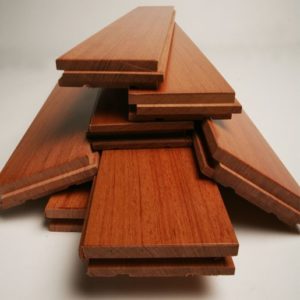
a. Solid wood floor
Solid wood flooring is made from a piece of wood which has thickness of around 20 mm. Solid wood flooring can be installed in any room of your house, except in areas where there is high moisture content such as kitchen, bathrooms and basements.
b. Engineered Wood Flooring
Engineered wood flooring is made with the core of plywood and a layer of solid wood attached on its top. Engineered wood flooring gives more attractive look than laminate wood flooring.
c. Laminate Wood Flooring
Laminate wood flooring is obtained by placing a layer of a photographic image of wood over a fibre board. But many modern laminates are actually quite realistic, and almost indistinguishable from wood. As it is a synthetic product, it gives look and feel of natural wood. Laminate wood flooring can be installed in any room such as living room, bedroom, and dining room except wet areas like bathroom and laundry rooms. If you’re thinking about laminate, here are a few pros and cons to consider.
PROS
It’s cheaper than wood.
The biggest thing laminate flooring has going for it is its price. Of course this will vary depending on the laminate you choose, but generally a laminate floor will cost much lower than natural hardwood.
It’s easier to install.
Laminate flooring comes in pre-cut planks that neatly lock together, and its softness makes it easier to cut. It’s quick to install and a fairly easy, so you can save even more money by installing it yourself. It can even be installed on top of an existing floor.
It’s very durable.
Since laminate flooring is finished with a tough ‘wear layer’, it’s very scratch-resistant, much more so than wood.
CONS
It can’t be refinished.
Since laminate is just fibre board with a thin wood-look layer on top, you don’t have the option of refinishing it if you decide you don’t like the color. Once the top layer wears out, the whole floor must be replaced.
It doesn’t last as long as wood.
A typical laminate floor will last about ten years. Natural wood floors, on the other hand, can last for 25 years or even longer.
It’s not suitable for wet areas.
Laminate’s glossy top layer makes it resistant to spills, but it’s not recommended for wet areas like bathrooms. If water stands on the floor and is able to soak between the planks, it can cause the floor to swell and the layers to peel apart.
Caring for a Synthetic Wood Floor
To keep a synthetic floor looking like the real thing, make sure to maintain it properly. Use a dust mop or vacuum regularly and clean up spills immediately with a damp cloth. Unlike earlier models, today’s laminate floors do not require any waxing or refinishing. Of course, you should always follow the manufacturer’s guidelines that comes with your floor.
Protect synthetic floors from scratches by using door mats to scrape dirt and rocks from shoes and by using soft castors under furniture such as chairs. By following proper maintenance procedures, you should be able to keep your synthetic floor for years.
PVC flooring is also known as vinyl flooring. These types of flooring material have a very smooth top surface and a rough l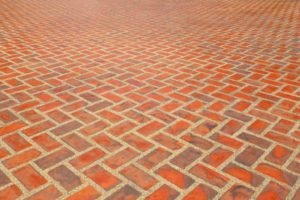 ower surface. Vinyl flooring is a good choice for areas that are prone to spills and moisture such as kitchens, bathrooms, laundry rooms, also for offices, etc.
ower surface. Vinyl flooring is a good choice for areas that are prone to spills and moisture such as kitchens, bathrooms, laundry rooms, also for offices, etc.
5. Brick Flooring
Brick flooring is one of the oldest types of flooring materials. It is majorly used in courtyards, stores, godowns, etc. Brick flooring is durable and provides sufficiently hard floor surface. It provides a non-slippery and fire-resistant surface.

